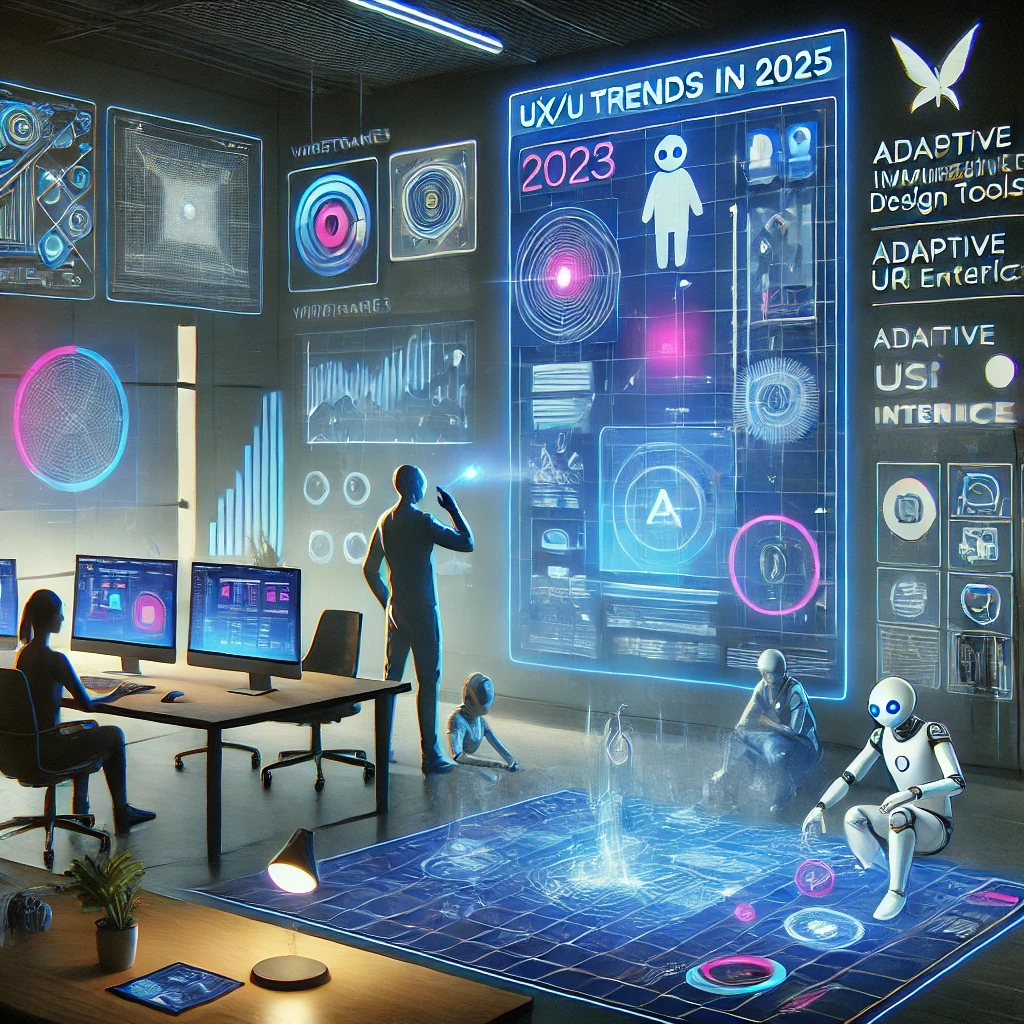User experience (UX) and user interface (UI) design are constantly evolving, driven by emerging technologies, changing user behaviors, and industry innovations. As we step into 2025, UX/UI trends are focused on intuitive, immersive, and personalized experiences. In this guide, we’ll explore the top UX/UI trends shaping digital design and how businesses can leverage them for better user engagement and conversions.

1. AI-Powered Personalization for Enhanced User Experience
Artificial intelligence is transforming UX/UI by enabling hyper-personalization. AI algorithms analyze user behavior, preferences, and interactions to deliver customized experiences in real-time. From dynamically adjusting content layouts to predictive text and chatbot interactions, AI is making interfaces more intuitive and user-friendly. Learn more about AI in UX design.
2. Immersive 3D and AR Experiences for Better Engagement
With advancements in web technologies and hardware, 3D elements and augmented reality (AR) are becoming integral to UX/UI. E-commerce sites use AR for virtual try-ons, while 3D illustrations add depth and engagement to interfaces. The rise of WebXR and VR interfaces is further pushing the boundaries of digital experiences.
3. Voice and Gesture-Based Interfaces for Seamless Interaction
Touchless interfaces are gaining popularity, especially in mobile apps, smart devices, and automotive UX. Voice commands, gesture-based controls, and haptic feedback create more seamless interactions. As AI-powered voice assistants improve, designers are incorporating voice UX (VUX) into their workflows.
4. Dark Mode and High-Contrast UI for Accessibility
Dark mode continues to be a preferred choice among users for both aesthetic and accessibility reasons. High-contrast UIs not only reduce eye strain but also improve readability for visually impaired users. Designers are focusing on adaptable themes that adjust based on user preferences and environmental conditions.
5. Microinteractions and Motion Design to Improve Usability
Subtle animations and microinteractions enhance user engagement by providing feedback and guiding user actions. From animated buttons to hover effects and loading animations, motion design creates a more dynamic and interactive experience without overwhelming the user.
6. Neumorphism and Glassmorphism for Modern Aesthetics
UI aesthetics are shifting towards neumorphism and glassmorphism, blending soft shadows, transparency, and blurred backgrounds to create futuristic yet user-friendly interfaces. These styles provide a balance between realism and minimalism, giving a sleek and modern touch to digital products.
7. Sustainable and Ethical UX/UI Design Trends
As users become more environmentally conscious, designers are embracing sustainable UX/UI principles. This includes optimizing images for faster loading times, reducing energy consumption through minimalistic design, and ensuring digital accessibility for all users.
8. Super Apps and Minimalist Navigation for Better User Flow
The rise of super apps—platforms that offer multiple services within a single ecosystem—is changing UX design. Instead of cluttered screens, minimalist navigation with intuitive UI patterns is gaining traction. Designers use card-based layouts, contextual menus, and swipe-based interactions to simplify the user journey.
9. AI-Assisted Design Tools for Faster Prototyping
AI is not just enhancing user experiences but also revolutionizing the design process itself. AI-powered tools like Figma’s AI features, Adobe Sensei, and OpenAI-powered design assistants are streamlining workflows, automating repetitive tasks, and enabling designers to create more efficiently.
10. Ethical and Inclusive UX Design for Digital Well-Being
Ethical UX/UI design is becoming a priority, with a focus on digital well-being, privacy-first design, and inclusivity. Designers are implementing transparent data policies, prioritizing accessibility standards, and ensuring that digital products cater to diverse user needs.
Conclusion
The future of UX/UI design in 2025 is centered on AI-driven experiences, immersive technologies, and user-first principles. Whether through hyper-personalization, motion design, or ethical considerations, the goal remains the same—creating intuitive, engaging, and meaningful digital interactions. Staying ahead of these trends is key to crafting cutting-edge experiences that resonate with users.
What are your thoughts on these UX/UI trends in 2025? Let us know in the comments!

